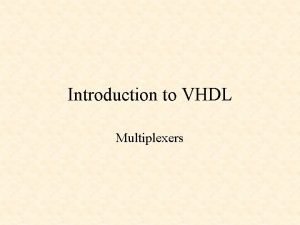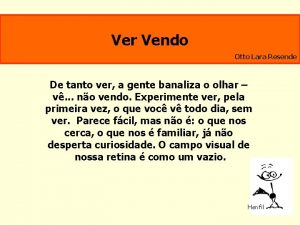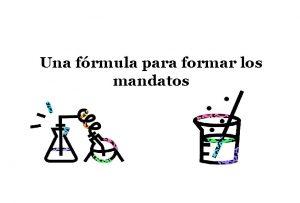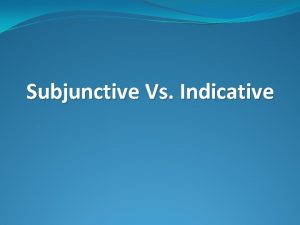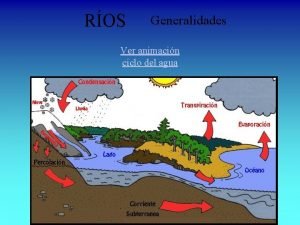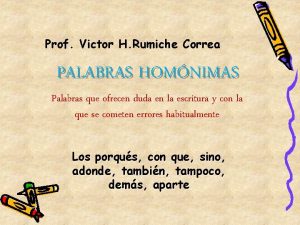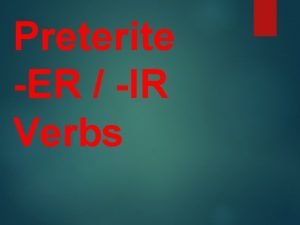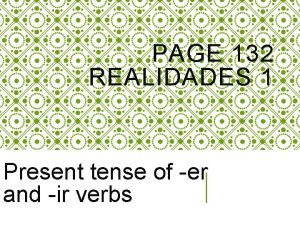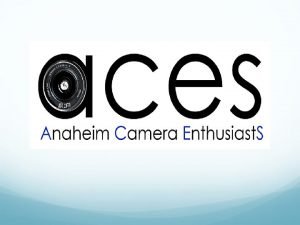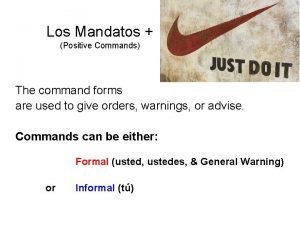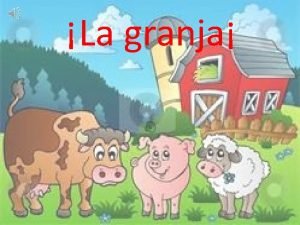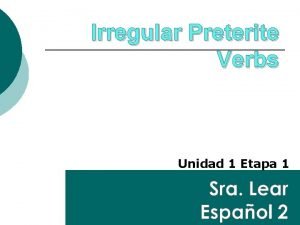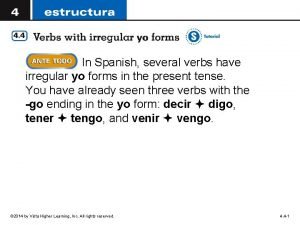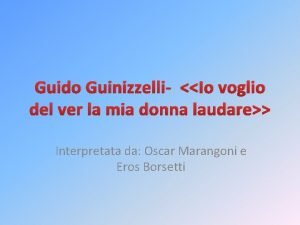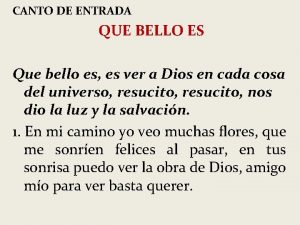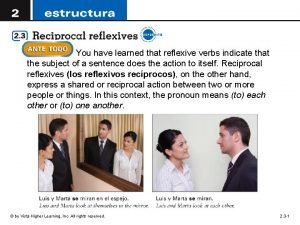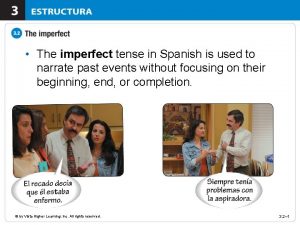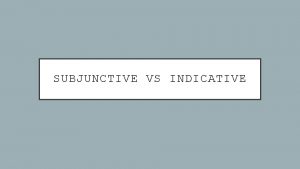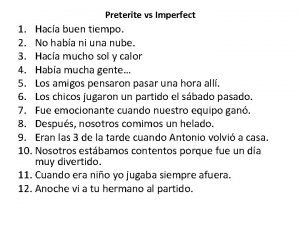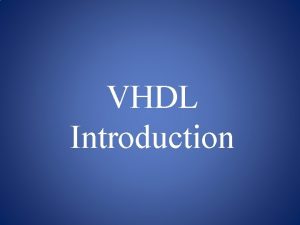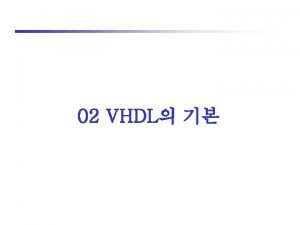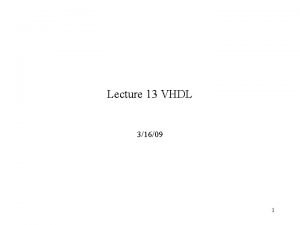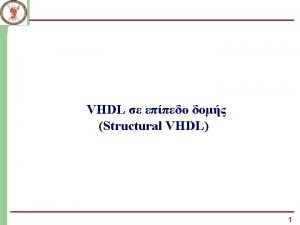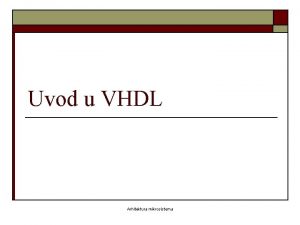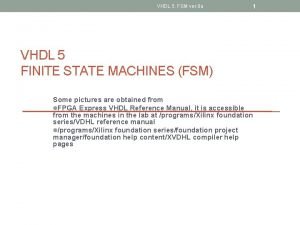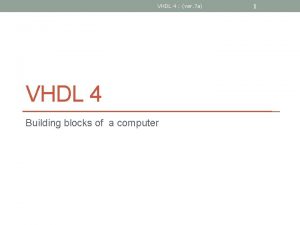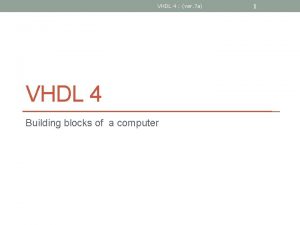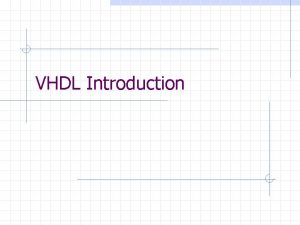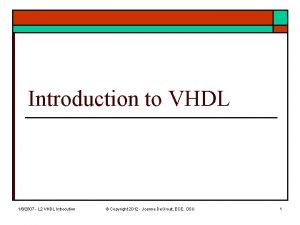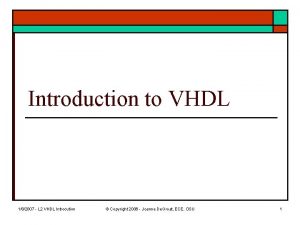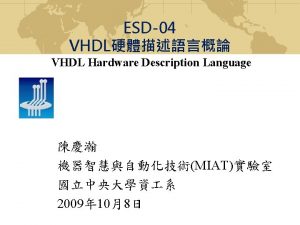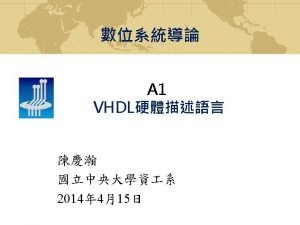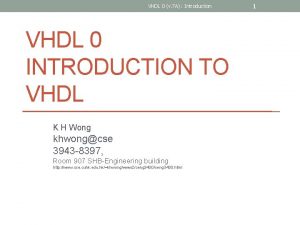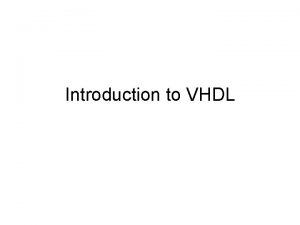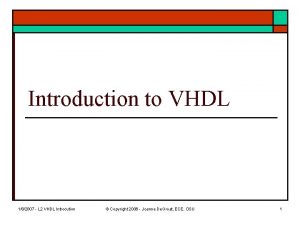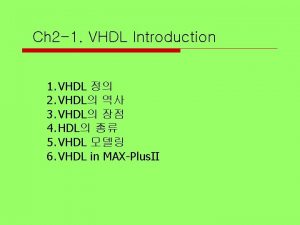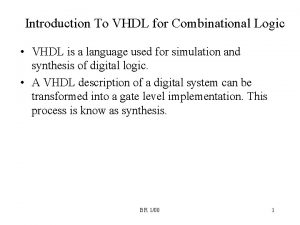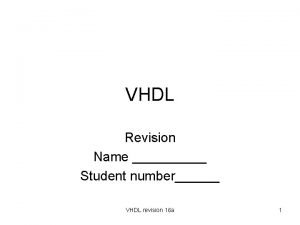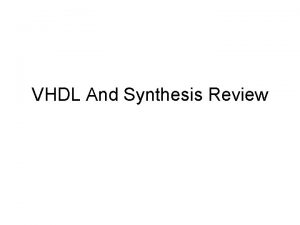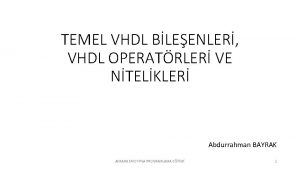VHDL 1 ver 7 a VHDL 1 INTRODUCTION




























- Slides: 28

VHDL 1. ver. 7 a VHDL 1 INTRODUCTION TO VHDL (VERY-HIGH-SPEED-INTEGRATED-CIRCUITS HARDWARE DESCRIPTION LANGUAGE) KH WONG (W 2 BEGINS) (Some pictures are obtained from FPGA Express VHDL Reference Manual, it is accessible from the machines in the lab at /programs/Xilinx foundation series/VDHL reference manual) 1

VHDL 1. ver. 7 a 2 You will learn • Basic structure: the Entity contains two parts • Entity • declaration : • Define the signals to be seen outside externally • E. g. Connecting pins of a CPU, memory • Architecture: define the internal operations of the device

VHDL 1. ver. 7 a 3 Resource & references • Book • Digital Design: Principles and Practices, 4/E John F. Wakerly, Prentice Hall. • High-Speed Digital Design: A Handbook of Black Magic by Howard W. Johnson and Martin Graham Prentice Hall. • BOOKBOON (Free text books) • Online resource , software in the lab.

VHDL 1. ver. 7 a Web resource on VHDL (plenty) • *Courses and tools • http: //equipe. nce. ufrj. br/gabriel/vhdlfpga. html • VHDL Quick Reference • http: //www. doulos. co. uk/hegv/ 4

5 VHDL 1. ver. 7 a What is an entity? Overall structure of a VHDL file Entity Library declaration Entity declaration Architecture body

VHDL 1. ver. 7 a 6 What are they? A VHDL file • Library declaration, e. g. IEEE library as follows library IEEE; use IEEE. std_logic_1164. all; use IEEE. std_logic_arith. all; use IEEE. std_logic_unsigned. all; Entity declaration Architecture body Architecture Body: defines the processing

VHDL 1. ver. 7 a 7 An example a comparator in VHDL • a=[a 3, a 2, a 1, a 0] b=[b 3, b 2, b 1, b 0] equals a 3 a 2 a 1 a 0 VHDL for programmable logic, Skahill, Addison Wesley b 3 b 2 b 1 b 0 The comparator chip: eqcomp 4 Equals (Equals=1 when a=b)

VHDL 1. ver. 7 a 8 Exclusive nor (XNOR) • When a=b, Output Y = 0 • Otherwise Y =1 a b a 0 0 1 1 b 0 1 Output : Y 1 0 0 1

An example of a comparator Library declaration Entity declaration 1) --the code starts here , “a comment” 2) library IEEE; 3) use IEEE. std_logic_1164. all; 4) entity eqcomp 4 is Entity declaration: defines IOs 5) port (a, b: in std_logic_vector(3 downto 0 ); equals: out std_logic); 7) end eqcomp 4; 8) architecture dataflow 1 of eqcomp 4 is 9) begin 10) equals <= '1' when (a = b) else '0’; 11) -- “comment” equals is active high 12) end dataflow 1; 6) Architecture body VHDL 1. ver. 7 a Architecture Body: defines the processing 9

VHDL 1. ver. 7 a How to read it? 10 Entity enclosed by the entity name – eqcomp 4 (entered by the user) • Port defines the I/O pins. 1) --the code starts here 2) library IEEE; Entity declaration • A bus, use downto to define it. • E. g. in std_logic_vector(3 downto 0); 3) use IEEE. std_logic_1164. all; 4) entity eqcomp 4 is 5) port (a, b: in std_logic_vector(3 downto 0 ); equals: out std_logic); 7) end eqcomp 4; 8) architecture dataflow 1 of eqcomp 4 is 9) begin 10) equals <= '1' when (a = b) else '0’; 11) -- “comment” equals is active high 12) end dataflow 1; 6) Architecture body

VHDL 1. ver. 7 a Student ID: _________ Name: ___________ Date: ________ (Submit this at the end of the lecture. ) • In the eqcomp 4 VHDL code: • How many Input / Output pins? • Answer: _______ • What are their names and their types? • Answer: ______ • __________ • What is the difference between std_logic and std_logic_vector? • Answer: _____ • _________ 11 Exercise 1. 1 • 1 entity eqcomp 4 is • 2 port (a, b: in std_logic_vector(3 downto 0 • • ); 3 equals: out std_logic); 4 end eqcomp 4; 5 6 architecture dataflow 1 of eqcomp 4 is 7 begin 8 equals <= '1' when (a = b) else '0’; 9 -- “comment” equals is active high 10 end dataflow 1;

12 VHDL 1. ver. 7 a Entity declaration: define the IO pins of the chip • entity eqcomp 4 is • port (a, b: in std_logic_vector(3 downto 0 ); • equals: out std_logic); • end eqcomp 4; Two input buses (a 3, a 2, a 1, a 0) (b 3, b 2, b 1, b 0) and one output ‘equals’ a 3 a 2 a 1 a 0 b 3 b 2 b 1 b 0 The comparator chip: eqcomp 4 equals

VHDL 1. ver. 7 a 13 Concept of signals • A signal is used to carry logic information. • In hardware it is a wire. • A signal can be “in” or “out”. . etc. • There are many logic types of signals (wires) • Bit (can only have logic 1 or 0) • Std_logic can be 1, 0 , Z. . etc. ( Z=float. ) • Std_logic_vector is a group of wires (called bus). • a, b: in std_logic_vector(3 downto 0); in VHDL • means a(0), a(1), a(2), a(3) are std_logic signals (meaning • Same for b. Standard logic, an IEEE standard)

VHDL 1. ver. 7 a 14 Exercise 1. 2 1 entity test 1 is 2 port (in 1, in 2: in std_logic; 3 out 1: out std_logic) ; 4 end test 1; 5 6 architecture test 1 arch of test 1 is 7 begin 8 out 1<= in 1 or in 2; 9 end test 1_arch; • • • • • Give line numbers of (i) entity declaration, and (ii) architecture? Also find an error in the code. _______________________ What are the functions of (i) entity declaration and (ii) architecture? _______________________ Draw the chip and names the pins. (Don’t forget the two most important pins) _________________________ Underline (or list) the words that are user defined in the above VHDL code. _________________________

VHDL 1. ver. 7 a Exercise 1. 3 • Rewrite code in example 1. 2, with • Entity name is not test 1 but • • test 1 x Inputs are not in 1 and in 2 but a, b, resp. Output is not out 1 but out 1 x Logic type is not std_logic but bit Architecture name is not test 1 arch but x_arch. Answer: 15

VHDL 1. ver. 7 a 16 ENTITY DECLARATION Define Input/Output (IO) pins Entity Library declaration Entity declaration IN port declaration declare modes( In out, inout, buffer) Architecture body

VHDL 1. ver. 7 a 17 More on Entity Declaration • entity do_care is port( s : in std_logic_vector(1 downto 0); • y : buffer std_logic); • end do_care; • 4 modes of IO pins in port • • in, • out, • inout (bidirectional) **User defined variables are in Italic. • buffer (can be read back by the entity)

18 VHDL 1. ver. 7 a Four modes of IO signals Example: entity do_care is port( s : in std_logic_vector(1 downto 0); y : buffer std_logic); end do_care; 4 modes of IO pins in port • Declared in port declaration IO Signal Modes in port Mode: in Mode: out Mode: inout Mode: buffer

VHDL 1. ver. 7 a 19 IN, OUT, INOUT, BUFFER modes • IN: data flows in, like an input pin • OUT: data flows out, just like an output. The output cannot be read back by the entity • INOUT: bi-directional, used for data lines of a CPU etc. • BUFFER: similar to OUT but it can be read back by the entity. Used for control/address pins of a CPU etc.

20 VHDL 1. ver. 7 a Exercise 1. 4 : On IO signal modes: IN, OUT, INOUT, BUFFER • State the difference between out and buffer. • Answer: ____________________ ___ • Based on the following schematic, identify the modes of the IO pins. A D E B F C G From VHDL for programmable logic, Skahill, Addison Wesley

21 VHDL 1. ver. 7 a Difference between buffer and inout • Buffer= it is an output but the output signal can be read back internally. Note: It cannot act as an input from an external signal. • Inout: can be input or output at different times but not at the same time. • So why E is a buffer, F is an inout? Answer: • E is signal with mode buffer because • Z=(A and B) drives E and E is an output but also at the same time X=(B and Z), this Z is feedback to the chip driving an internal signal. F cannot act as an input from an external signal. • F is signal with mode inout because • If C is 1, X drives F, so F is an output at that time. • However, when C is 0, F is an input that receives an input to drive Y at that time. • Note: F can be ‘in’ or ‘out’ at different times but not at the same time. A tri-state buffer Z x y

22 VHDL 1. ver. 7 a Entity Library declaration Entity declaration THE ARCHITECTURE BODY Define the internal architecture/operation Architecture Body

VHDL 1. ver. 7 a 23 Architecture body: defines the operation of the chip • Begin …tells you the internal operation…. . • ……. . • end • • 6 architecture dataflow 1 of eqcomp 4 is Architecture body • 7 begin • 8 equals <= '1' when (a = b) else '0’; • 9 -- “comment” equals is active high • 10 end dataflow 1;

VHDL 1. ver. 7 a 24 How to read it? • Architecture name -- dataflow 1(entered by the user) • equals, a, b are I/O signal pins designed by the user in the entity declaration. • The operation: equals <= '1' when (a = b) else '0’; • “--” means comment 6 architecture dataflow 1 of eqcomp 4 is 7 begin 8 equals <= '1' when (a = b) else '0’; 9 -- “comment” equals is active high 10 end dataflow 1;

VHDL 1. ver. 7 a 25 Exercise 1. 5: Draw the schematic circuit 1) 2) 3) 4) 5) 6) 7) 8) 9) 10) 11) 12) 13) library IEEE; use IEEE. STD_LOGIC_1164. ALL; entity test 2 v is port (in 1 : in std_logic_vector (2 downto 0); out 1 : out std_logic_vector (3 downto 0)); end test 2 v; architecture test_arch of test 2 v is begin out 1(0)<=in 1(1); out 1(1)<=in 1(2); out 1(2)<=not (in 1(0) and in 1(1)); out 1(3)<='1'; end test_arch ;

26 • Exercise 1. 6: Multiple choice question: What is this circuit? (a) encoder, (b) decoder, (c)multiplexer or (d) adder. Answer: ____ • Fill in the truth table of this circuit • Fill in the blanks of the program listed below for this circuit. In 1 in 2 0 0 1 1 entity test 16 is 2 port (in 1 , in 2: in std_logic; 3 out 00, out 01, out 10, out 11 : out std_logic); 4 end test 16; 5 architecture test 16_arch of test 16 is 6 begin 7 out 00<=not (____________); 8 out 10<=not (____________); 9 out 11<=not (____________); 10 out 01<=not (____________); VHDL 1. ver. 7 a 11 end test 16_arch ; out 00 out 11 out 01

VHDL 1. ver. 7 a Exercise 1. 7: • Write a VHDL program that implement the formula • F= (/a+b). /c 27

VHDL 1. ver. 7 a 28 Summary • learned • Entity declaration • Use of port() • Modes of IO signals • Structure of the Architecture body of a simple VHDL program
 Mattos nascimento no dia de pentecoste
Mattos nascimento no dia de pentecoste Introduction to vhdl
Introduction to vhdl Ver vendo otto lara rezende
Ver vendo otto lara rezende Mandatos tu positivo
Mandatos tu positivo Decir subjunctive
Decir subjunctive Ver
Ver A parte o aparte
A parte o aparte Preterite er/ir
Preterite er/ir Analise do poema ver claro de eugenio de andrade
Analise do poema ver claro de eugenio de andrade Conjugation chart for estar
Conjugation chart for estar Astro luminoso centro de nuestro sistema planetario
Astro luminoso centro de nuestro sistema planetario Verexif
Verexif Dar mandato formal
Dar mandato formal Venha ver o por do sol resumo
Venha ver o por do sol resumo Vamos a ver mi rancho que es hermoso
Vamos a ver mi rancho que es hermoso Preterite ver
Preterite ver Irregular yo verbs spanish
Irregular yo verbs spanish Hemokoncentráció
Hemokoncentráció Ah bir ataş ver hikayesi
Ah bir ataş ver hikayesi Formas de ver la vida
Formas de ver la vida Parafrasi io voglio del ver la mia donna laudare
Parafrasi io voglio del ver la mia donna laudare De tanto ver triunfar as nulidades texto completo
De tanto ver triunfar as nulidades texto completo Que bello es dios
Que bello es dios Ao observarmos o ceu a noite podemos ver os astros
Ao observarmos o ceu a noite podemos ver os astros Indica el reflexivo reciproco adecuado
Indica el reflexivo reciproco adecuado Ver imperfect
Ver imperfect When to use subjunctive
When to use subjunctive 3a-3 realidades 2 answers
3a-3 realidades 2 answers Mis amigos / ver / una película de horror / anoche
Mis amigos / ver / una película de horror / anoche

